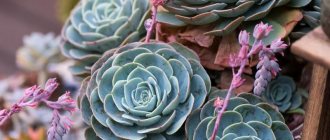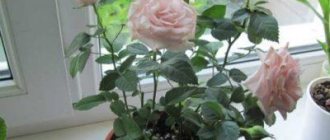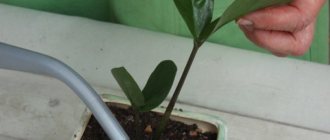Caring for indoor roses at home
The bush can be classified as a very high-maintenance plant. The main rules for growing are:
- Keep the flower at an air temperature of +15 to 25 degrees.
- Spray the foliage weekly with a spray bottle: carry out water treatments early in the morning or in the evening, when it is not very hot outside. If it’s cold at home, you can do without spraying. When it's hot, perform water procedures every 3-4 days.
- For active development, it is important to have a 15-hour daylight hours.
- Caring for a rose involves regular application of organic and mineral fertilizers.
Location and lighting for the plant
In order not to ruin the plant and to promote its active development, a number of recommendations should be taken into account. Caring for homemade roses in a pot includes the following:
- Place the bush on the balcony or put it outside in the summer (ideal if you have a garden plot). At home, place the flower on a south or southeast window.
- In autumn and winter, use fluorescent lamps: this will extend the flowering period.
- During wintering, maintain the temperature from +12 to +15 degrees. If there is an insulated balcony or loggia, then place the bush there. To avoid soil freezing, place the flower pot in a box with sawdust.
- Protect the flower from the heat: do not place it near radiators or heating devices.
- To avoid drying out the soil, place the flower pot in a tray with damp pebbles: follow this recommendation, especially in winter.
- To form a beautiful bush, regularly turn it towards the light with different sides.
What does an indoor rose like?
Priming
When caring for roses, it is important to use nutritious, breathable soil with neutral acidity. It is better to buy a ready-made substrate. If you are going to prepare the soil yourself, then take turf, humus soil, sand: the proportions of the components are 4: 4: 1. If all the rules for preparing the nutrient mixture are followed, then when caring for the plant you will not often need to loosen the soil: remember that the procedure is not recommended, because it can damage the root system.
Watering
Constantly monitor the soil, do not allow it to dry out or become waterlogged. Keep in mind that watering should be plentiful only during active flowering. Caring for an indoor rose in a pot should be as follows:
- For irrigation, use settled water at room temperature.
- In the summer, when indoor roses bloom profusely, organize abundant and frequent watering: moisten the soil daily, morning and evening.
- In the fall, when the foliage falls, watering is reduced - every 7 days. Follow this recommendation if the indoor rose is located on a balcony or loggia, where coolness prevails. When the pot is located at home, where it is very warm, when watering you should focus on the soil - moisten it if the top layer is dry.
- When caring for a rose in an apartment, alternate top and bottom watering - moisten the soil or add water to the pan. In the second case, after a few hours, drain the excess liquid to avoid rotting of the root system.
- In the spring, the indoor rose wakes up and begins to actively develop, so gradually increase watering.
Caring for a ROOM ROSE
Fertilizers
To ensure that the bush enjoys abundant flowering, fertilize it regularly. When caring for roses at home, consider the following tips:
- Apply nutritional formulations from early February to November: fertilize the soil every 2 weeks, and reduce the frequency of fertilizing in the fall.
- Alternate mineral supplements with organic ones. Use ready-made preparations, bird droppings, manure: pour the fertilizer with water and leave for 10 days, then strain the composition, dilute with water (when using manure, the ratio is 1:5, if droppings are used, then the proportion is 1:10).
- After transplanting the bush, fertilize it 2 weeks later.
- Before adding the nutrient mixture, moisten the soil well: if you neglect this recommendation, burns may occur on the roots.
- In autumn, during dormancy, use additives with a small amount of nitrogen: use Bonsa, mix the drug with water (1.5 ml per 1 l).
- In spring, for better foliage development, add nitrogen-containing mixtures. To avoid bud drop, add potassium. Special preparations or organic matter - litter and manure - are suitable. To form roots, add phosphorus: apply fertilizers according to the established instructions, remember that with an excess of phosphorus, an indoor rose will develop a manganese deficiency.
- When caring for roses at home in the summer, apply foliar feeding: this provides nutrition for the foliage and protection from diseases.
Remember that it is better to use a smaller amount of the nutrient composition than to water the bush with an excessive amount of the mixture. Find out about popular fertilizers for indoor roses and the frequency of their use:
| Drug name | Application frequency |
| "Fertile-Lei-Ka" | In spring, summer - every 10-15 days, in winter - every 30 days. |
| "Agricola-Aqua" | Watering - every 7-10 days, foliar feeding - every 14 days. |
| "Rose" | In spring, summer - every 10-15 days, in autumn, winter - every month. |
| "Ambulance for Roses" | A month later. |
| "Pokon" | In spring, summer - every 14 days, in winter - every month. |
| "Gloria" | In spring - every 14 days, in winter - every 60 days, in summer - every 7 days, in autumn - every month. |
We create optimal conditions
However, the soil in the pot should not heat up, and the bush itself should not suffer from direct sunlight. An excellent place for a rose will be the western and eastern windowsill. In summer, the rose will be more comfortable on the balcony.
One of the prerequisites is to constantly maintain soil moisture. It’s worth noting right away that in many gardening manuals you can read that roses need to be provided with abundant watering. But you need to keep in mind that abundantly does not mean often. The root ball should have time to dry out. It’s time to water the rose only if your finger remains dry when pressing on the soil. If you overwater, the roots may rot and the rose will die.
The condition of the coma should be monitored especially carefully in the summer. A plant placed on the balcony sometimes needs to be watered up to twice a day, but not in the hottest time.
Roses planted in small pots need to be watered more often, as the soil in them dries out faster. In the second half of August, watering should be reduced. The plant is watered with 20-degree water. Half an hour after “watering” the bush of the pallet, excess water is removed.
Top dressing
Indoor roses bloom almost all the time, which takes a lot of their energy. Therefore, from March to October, once every eight to nine days, the bushes must be fed with complex or universal fertilizers. Fertilizers with organic matter are also suitable. In spring, roses are responsive to foliar feeding. It is enough to carry out three or four sprayings at 10-day intervals.
Indoor roses urgently need a large amount of different fertilizers.
Many gardeners advise purchasing Bona Forte for roses. The drug is excellent for both foliar application and root application.
Open ground fertilizer Bona Forte for Roses
More benefits come from fertilizers applied in the evening and after watering. At low temperatures and dampness, it is better to refuse feeding and postpone it. If you have just transplanted roses, then carry out the first feeding only after a month, then every two weeks until new shoots appear.
Proper care is the key to abundant flowering
Of course, sometimes it can be difficult to find a common language with roses: they suffer from changing conditions, they may spontaneously get sick or not forgive you for too dry soil, lack of fertilizing, etc. But if you provide them with proper care, in gratitude they will delight you with abundant flowering for almost seven months!
The rose has been the queen of flowers since ancient times. Its magical and enchanting beauty touches the hearts of many gardeners. There are no people who would be indifferent to her. Roses are so diverse that for each home you can choose exactly the type and variety that suits only it.
Many people consider roses to be too finicky and are afraid to start growing them. Of course, during the growth of a flower you may encounter certain difficulties. But even with them, if done correctly, they are quite easy to deal with. Most problems arise during the process of replanting a plant. This process must be approached with special care. In this article we will tell you how to replant a flower after purchasing it and how to properly care for your indoor rose at home.
How to replant an indoor rose
As a rule, a crop is replanted after purchasing it or to renew the soil or replace the pot. If an indoor rose was purchased, then follow these instructions:
- Do not touch the flower for 2 weeks, let it adapt.
- Place the container with the rose in a pan of water and wait half an hour.
- Carry out a water procedure: give your indoor rose a contrast shower (hot water should not be higher than 40 degrees).
- After bathing, make a greenhouse out of polyethylene: cover the bush with a bag so that it does not touch the foliage, pin the edges of the bag to the ground.
- Ventilate the greenhouse daily.
- Look at the condition of the flower. If the buds begin to fade, then the plant is ready for replanting.
- Remove the bush from the pot, immerse the roots in a container of warm water - this will help wash away the remnants of the substances with which the crop was previously treated.
- The new pot should be slightly larger than the previous one. Soak the container in water for a day: due to this, the dishes will absorb moisture and subsequently will not “take” water from the soil.
- Place drainage at the bottom of the pot, then add soil.
- Place the plant in a container, cover the roots with soil, compact it tightly.
Replanting may be necessary if the pot has become too small for the bush. The new container is thoroughly cleaned (you can use a manganese solution) and soaked in water for a day to absorb moisture. The pot with the bush is placed in a pan of water for half an hour: due to this, the earthen lump will be easier to separate from the dishes. Next, the flower is transferred to a new container and covered with earth. There is no need to water the soil. Place the pot in the shade for a few days, then move it to the light. Apply fertilizers a month after transplanting.
Transplanting indoor roses.
Rules for care after purchase
Actions that need to be taken immediately after purchasing a rose in a pot:
- Inspect the bush, make a general assessment of the condition of the plant and check it for pests.
- Trim dry and wilted elements.
- Leave no more than 5 buds on each shoot, cutting off the rest.
- Treat the flower with a protective composition against pests.
- Treat with a fungicide solution to prevent possible diseases.
- Remove the flower with roots and part of the soil if there is excess moisture in the pot.
After these procedures, the plant should be placed in a cool place where there is no direct sunlight or drafts. You need to allocate 3-5 days for adaptation, during which the rose cannot be replanted. During this time, the flower must be sprayed regularly, using not only water, but also growth stimulants. After a couple of weeks, the flower can be transplanted into a prepared pot.
Bloom
If proper care is provided for your home rose, it blooms from April-May to October. The constant formation of new buds occurs due to the timely removal of dry flowers. Remember that an indoor rose may not please with its splendor due to the heat. Prevent the pot from overheating in the sun: wrap the container in white paper, do not place the bush in the sun.
It often happens that a crop does not bloom. This occurs due to improper care at home:
- lack of the required amount of light - it is necessary to move the pot to a south, south-west window, an insulated balcony or loggia, and install fluorescent lamps;
- unsuitable soil - you need not too loose, water-permeable, breathable soil with neutral acidity - pH 6.5-7.5;
- it is too hot or cold in the room - you need to move the plant to a place where humid air prevails, the air temperature is from +15 to 25 degrees, there are no drafts;
- insufficient nutrition - organic and mineral fertilizers should be applied in a timely manner;
- too much pruning - undesirable in the presence of an adult, weakly developing bush;
- improper formation of the bush - you need to prune the bush correctly in the fall;
- the presence of diseases, pests - carefully monitor the condition of the crop, if necessary, urgently treat it with special preparations.
In autumn, the plant is moved home from the street. It is important that the air temperature at home is +15-18 degrees. Do not place the crop near heating appliances. After the end of the budding period, pruning should be done - remove shoots and stems so that 5 buds remain on them. Caring for a rose at home in the fall involves gradually reducing watering and stopping fertilizing.
- Roast pork - recipes step by step with photos. How to cook roast pork with gravy in a frying pan
- Potato balls: recipes with photos
- How to make a crystal from salt
We create optimal conditions
A rose purchased in a store can be replanted at any time of the year. But experienced experts recommend doing this in early spring or August.
Beginning gardeners should know that garden roses are not intended for planting at home. Only an indoor plant variety can take root on your windowsill. It differs from the garden rose in size and type. But you should know how to transplant a domestic rose into another pot.
Before boarding, you should know some rules:
- The flower can be replanted only 2-3 weeks after purchase. This procedure must be performed only with a healthy plant. It should show no signs of disease or wilting.
- Drainage in the pot is a prerequisite for replanting. It ensures the removal of excess water, which means that the root system will not rot and will remain intact and healthy.
- Drainage can be expanded clay, fragments of a clay pot, pieces of polystyrene foam, or river pebbles.
- If you are replanting a plant that has finished flowering, it will need to be pruned. You can leave no more than 2-3 buds on the shoots.
- Many gardeners rely on the lunar calendar. They advise replanting the rose during the waxing moon.
Replanting a plant is quite simple. But you should know some of the nuances of how to properly replant a rose in a pot in order to quickly see the results of your activities.
An indoor rose must be replanted with a lump of earth. Therefore, this process is often called “transshipment”. Fresh substrate is added to the bottom of the container and along its sides, filling the entire volume. It is not recommended to compact the soil. Simply fill the container to a certain level after watering the plant.
And having already placed the indoor rose in a permanent place, you need to spray the plant with settled water 2 times a day.
Many experts recommend replanting the plant annually. All work is carried out according to the same principle. The bush needs to be transferred to a larger container and the required amount of soil should be added.
For a large, overgrown bush, you should not purchase a large container. Water will constantly stagnate in it, and the soil will become sour. Fertilizing is applied only in spring when transplanting.
However, the soil in the pot should not heat up, and the bush itself should not suffer from direct sunlight. An excellent place for a rose will be the western and eastern windowsill. In summer, the rose will be more comfortable on the balcony.
One of the prerequisites is to constantly maintain soil moisture. It’s worth noting right away that in many gardening manuals you can read that roses need to be provided with abundant watering. But you need to keep in mind that abundantly does not mean often. The root ball should have time to dry out. It’s time to water the rose only if your finger remains dry when pressing on the soil. If you overwater, the roots may rot and the rose will die.
The condition of the coma should be monitored especially carefully in the summer. A plant placed on the balcony sometimes needs to be watered up to twice a day, but not in the hottest time.
The rose on the balcony is watered twice a day
Top dressing
Indoor roses bloom almost all the time, which takes a lot of their energy. Therefore, from March to October, once every eight to nine days, the bushes must be fed with complex or universal fertilizers. Fertilizers with organic matter are also suitable. In spring, roses are responsive to foliar feeding. It is enough to carry out three or four sprayings at 10-day intervals.
Indoor roses urgently need a large amount of different fertilizers.
Many gardeners advise purchasing Bona Forte for roses. The drug is excellent for both foliar application and root application.
Open ground fertilizer Bona Forte for Roses
More benefits come from fertilizers applied in the evening and after watering. At low temperatures and dampness, it is better to refuse feeding and postpone it. If you have just transplanted roses, then carry out the first feeding only after a month, then every two weeks until new shoots appear.
Proper care is the key to abundant flowering
Of course, sometimes it can be difficult to find a common language with roses: they suffer from changing conditions, they may spontaneously get sick or not forgive you for too dry soil, lack of fertilizing, etc. But if you provide them with proper care, in gratitude they will delight you with abundant flowering for almost seven months!
Trimming
It is best to prune the flower in the spring with 10 hours of daylight, when the crop is actively developing, or in the fall, before wintering. When pruning, branches that have lengthened over the winter, weak shoots, and dried flowers are removed. Use a sharp knife to avoid leaving ragged areas that could cause the plant to die. Trim branches to 5mm above outward-facing buds. Be sure to make oblique cuts. There are the following types of pruning:
- Light - 2/3 of the stem length is removed. This treatment method is recommended for vigorous bushes. Do not prune your indoor rose this way for several years in a row, otherwise it will become very elongated and will not bloom.
- Moderate – approximately half the length of the stem is removed. Use this method if you have an adult indoor rose at home.
- Strong - used if the plant is young or needs to be renewed. The shoots are cut to the level of the third and fourth buds from the base.
PRUNING A ROSE. When and how to prune an indoor rose correctly!
Feature 1: Substrate and Pots
To grow roses at home, you need to know that the garden variety is not suitable for this. There is a special variety for growing in the house - indoor rose, which differs from garden roses in the size and type of flowers.
If you purchased an indoor rose at a flower shop, you should not replant it immediately; you need to know some rules:
- The rose is a very vulnerable flower, so it needs to adapt gently to its new habitat;
- Rose transplantation can begin after 2 - 3 weeks, if there are no signs of disease or wilting;
- when planting a rose, it is necessary to provide drainage so that the roots do not rot from a possible excess of moisture;
- Expanded clay is good for plant drainage.
Immediately after planting, the rose should be placed in a dark place or on a north window, and the next day it can be moved to its permanent habitat.
Soil for planting
Rose is very picky about the soil in which it grows. If you plant it in the wrong soil, it may not bloom and stop developing.
- It is best to plant a rose in special soil, which is sold in flower shops;
- For good rose growth, mix one part of sand and four parts of humus and turf soil;
- Before planting a flower, you should water the soil well and let the water soak in for about 20 minutes.
Choosing a pot
To choose the right pot for an indoor rose you need to know:
- the pot for replanting should not be much larger than the previous one;
- the new flowerpot should be two fingers taller and wider, since the rose develops its root system to fit its size and may forget about flowering;
- if the pot is new and nothing was grown in it, before planting it must be soaked for two hours in warm water;
- If a plant was previously grown in a pot, it must be washed well with a brush without soap.
Helpful Tips:
- The thickness of the drainage layer when planting a rose should be no less than one centimeter.
- If the rose pot has no holes, add 3 to 5 centimeters of drainage.
- The above-ground part of the rose should be in a 1:1 ratio with the height of the pot.
Reproduction
When caring for a rose at home, you may need to propagate it. Many gardeners choose the cutting method. The branches are cut using a sharp knife, which has been previously treated with a solution of manganese or alcohol. Make an oblique cut, under the bud: with this approach, the cutting will take root well. The upper cut is made 5 mm above the kidney. Remove the leaves from the bottom of the cutting. Next, you can perform soil propagation:
- For 10-12 hours, place the cuttings in a solution with heteroauxin (take 4 tablets per 1 cup of water).
- Plant the cuttings in sand (you can add peat).
- Create a greenhouse from a plastic bag or cut-off bottle.
- Do not water the cuttings.
- Make sure that the temperature inside the greenhouse is at least +18 degrees.
- Do not place the container with cuttings in direct sunlight.
- After a month, the branches will take root, after which remove the greenhouse to adapt them to the air at home.
There is another popular method of propagation, when the cuttings are placed in water for a long time. The growing instructions are as follows:
- Cutting cuttings is the same as for soil propagation. The only difference is that their length should be 15 cm.
- Take a jar or glass of water and cover the container with a lid with holes. You need to insert cuttings into the holes. They should be immersed in 2 cm of water.
- If the house is hot, spray the branches daily.
- Transplantation into the ground is carried out after roots grow 1.5 cm long. Remember that cuttings develop better in the presence of a lot of light.
How to properly care
When the weather is warm outside, the flower is transferred to an open balcony or courtyard. Fresh air benefits the plant. As a result, it not only develops better, but also produces more beautiful and vibrant flowers.
After waiting for the first buds to appear, they need to be cut off. This operation stimulates the formation of new ones. In this case, the next flowers will be brighter and will not fall off until frost.
If you notice signs of wilting flowers, they should be removed in a timely manner. Moreover, it is recommended to choose a moment for this when the petals do not yet show signs of falling off on their own.
Also, a home rose needs periodic pruning. This operation is carried out on withered leaves and dried twigs, which should be removed immediately, otherwise they will create favorable conditions for the emergence of diseases.
At the end of summer, you need to make changes to fertilizing: during this growing season it is not recommended to apply fertilizers rich in nitrogen. The fact is that in the fall there comes a time when the home beauty is preparing to go into a state of rest.
Therefore, at this stage of development it does not need such an element. You can already keep an indoor rose on a cool loggia, and the air temperature there should not be higher than 10 degrees.
The flower remains dormant all autumn and winter until February. This is manifested by the yellowing of its leaves. If you notice that the leaves have begun to fall, you should not speculate that there is something wrong with the plants. That's how they all work. And later, when the time comes, and this happens in the spring, new leaves will grow in place of the fallen leaves.
When February comes, the rosette's living conditions are changed so that she can come out of her sleep state. To do this, it is taken to a warmer room and transplanted into new soil. If the cold does not harm the plant, then in the first weeks of March you will already be able to enjoy the first flowers.
An effective technique that allows you to speed up flowering is pruning. This should be done at the moment the first buds form. Trim the branches of indoor roses by no more than a third.
If the shoot does not have buds, it is completely cut off. After this, abundant watering is carried out, fertilizers are applied and the room is regularly ventilated. When warm weather sets in, the flower pot is again taken out into the fresh air.
What to do if a rose in a pot dries out
This problem is often encountered both in summer and winter. When caring at home, indoor roses may dry out due to:
- the presence of a damaged root system: the plant stops absorbing nutrients and moisture;
- insufficient watering;
- low humidity levels;
- too dry air, heat: often the leaves dry out due to the placement of the flower near the radiators.
After discovering dry foliage, immediately begin rescuing the plant. Do the following:
- Check the ground. If it is dry, then water the flower well.
- Make sure the pot is kept away from heating devices. If necessary, move the indoor rose.
- Place the pot in a tray with damp expanded clay.
- Spray the foliage: repeat the procedure every 4 days.
- If the bush is small, then cover it with a transparent bag or bottle to maintain a high level of air and soil humidity. Keep the plant like this until it is completely restored.
Rules of care
How to care for a purchased rose in a pot? “Queen of Flowers” is a fastidious plant. Therefore, if all the conditions for its maintenance are not created at home, it will simply wither. In addition, the rose needs regular watering, pruning and feeding.
Watering
Water the rose with settled or filtered water at room temperature as the soil dries. It should be sprayed throughout the growing season. And, if the plant is located near the radiator, it is better to place the flower pot in a tray with wet expanded clay.
Top dressing
Regular feeding is carried out from spring to winter. Once every 2-3 weeks, specialized complex fertilizers for rosaceae are applied to the roses. Experienced gardeners recommend adding a small amount of fertilizer with each watering. This way the nutrients are absorbed by the plant much better. By autumn, feeding is stopped, gradually reducing their frequency.
Trimming
The main purpose of pruning roses is to form bushes. It is produced in the spring. At this time, all long shoots, faded buds and dry branches are removed from the plant.
Shrub roses in a pot are also pruned for further propagation by cuttings. To do this, shoots of the plant up to 15 cm long are cut, placed in the ground, and covered with a bottle or plastic bag. The cuttings will take root in 2-3 weeks. After the formation of new leaves, the “greenhouses” are removed. Moving seedlings to new containers can begin after the root system has developed and become strong enough.
Diseases and pests
Flower growers often complain about various diseases of their plants. Often illnesses appear due to improper care at home. An indoor rose may suffer from the following diseases and pests:
| Disease, pests | External signs | Causes | Fighting methods |
| Spider mite | The foliage turns yellow, falls off, cobwebs appear, and the plant gradually dries out. | Insufficient air humidity, drying out soil. | It is almost impossible to get rid of it at home. Methods are used to prevent the appearance of the pest: in spring and autumn, the plant is treated with special preparations such as “Fitoverma” (2 ml per 1 liter of water), “Aktellika” (1 ml per 1 liter of water). When processing foliage, alternate the compositions to avoid addiction. Prevention - regular spraying, bathing in the shower. |
| Powdery mildew | It is a fungal disease, the sign of which is a white coating on the foliage. | Occurs due to increased soil and air humidity. | If no measures are taken, the plant will die. When treating at home, use the drug “Topaz” (2 ml per 5 liters of water) every 14 days. Prevention of the disease - moderate watering, removal of dry leaves under the bush, loosening the soil. |
| Blackleg | The stem begins to turn black. | Occurs due to excessive watering and weak immunity of the flower. | To cure an indoor rose at home, water it with a strong solution of manganese potassium, a mixture of water and Fitosporin (component ratio 2:1). This method is suitable if the disease has not developed too much. If it is neglected, it will not be possible to save an indoor rose at home. |
| Chlorosis or iron deficiency | The leaves turn yellow, fall off, and green stripes appear along the veins. | Unsuitable soil: excessive acidity or alkalinity, lack of iron in the composition. | For treatment, foliar feeding is carried out using chelated iron or other nutritional sprays with the required content of the substance. Check the soil pH: the desired value is 6.5-7.5. If necessary, eliminate excess acidity and alkalinity: add lime or, to increase acidity, rotted manure, “Superphosphate,” or phosphorus flour. |
| Thrips or rose aphids | Leaves and buds are deformed. | The presence of dry foliage under a bush, contaminated soil or a neighbor's rose garden. | Treatment at home is carried out with insecticides: “Aktara”, “Fitoverm”. |
| Black spot | Dark spots with a diameter of 6 to 16 mm on the outside of leaves, young shoots and stems. Over time, the foliage turns yellow and falls off. Culture lags behind in development. | Increased air and soil humidity, lack of light, lack of treatment of branches with coal after pruning, excess nitrogen fertilizers. | When caring at home, spray with fungicides: “Ridomil”, “Fundazol”, “Profit”, “Topaz”, Bordeaux mixture. |
| Gray mold | Brown and black spots on foliage. The foliage turns yellow, falls off, and without treatment, the crop dies after 2 seasons. | Purchase of an infected plant, lack of timely fertilizing, pruning, loosening of the soil, presence of foliage under the bush. | The method of control when caring at home, as in the previous case. |
| Rust | Reddish-brown spots on the leaves. | Increased soil and air humidity, excessive watering. | It is important that there is good air circulation at home. Spray with Topaz, Abiga-Peak, Bordeaux mixture, and copper sulfate solution. Prevention - regular loosening of the soil, moderate watering, regular ventilation of the room. |
We treat indoor roses from diseases! The most common diseases of roses and their treatment!
When is the best time to do this?
Due to numerous unsuccessful attempts to breed indoor roses, the prickly beauties have acquired the status of capricious sissies.
- Cordan.
- Turbo.
- Patio.
The last plant belongs to garden roses, which is the reason for their larger bushes and inflorescences. The maximum height of an indoor rose is 25 cm. This beautiful bush blooms in May-October.
The leaves and shoots are examined first. With a fungal disease, there are black spots on the shoots. The denser the leaves, the better. Ideally, they should also be shiny. Powdery mildew will be indicated by a white coating. With brown and black spots, we can safely talk about fungus. Yellow leaves indicate depletion of the plant
Also pay attention to the presence of young shoots. Their presence is evidence of growth and good adaptation of the plant
As a rule, the age of store-bought miniature roses is three months. They haven’t really gotten stronger yet, but they are already forced to exchange the comfortable conditions of professional greenhouses for the not-so-ideal conditions of an apartment.
Even in the absence of lesions, it is important to please the plant with a warm shower. This trick will eliminate the possibility of it being affected by spider mites.
Treating the bush with Aktara will be useful.
Actara for processing purchased roses
To combat spider mites we use Agroverin
Experienced gardeners immediately replant a faded plant. In doing so, they comply with the following rules:
- 1-3 cm drainage is required.
- Pruning shoots of faded transplanted roses. A couple of buds remain.
- The flowerpot should be larger than the old one by about six centimeters in height and a couple of centimeters in diameter. But, of course, if the purchased rose sits in a miniature glass, you should take a larger pot. Usually the flowerpot is selected in such a way that its height is approximately the same as the height of the bush itself. For the first year, it is better to choose a pot with a 10-centimeter height and a 10-centimeter diameter.
- Composition of the mixture prepared on your own: turf soil, leaf soil, peat, sand. The ratio of ingredients is 4:2:2:1. Fine expanded clay (just a little bit) will be useful - it will remove excess moisture from the mixture.
- Preserving the integrity of the coma during transplantation and carefully transferring it into a new pot, followed by adding new soil around the edges.
- 2-fold treatment of the plant with a growth stimulator. For this purpose it is better to use Zircon.
The first two weeks will be the hardest for the rose; it may even shed its leaves. But after adaptation, the bush will begin to grow again.
An indoor rose can be replanted at any time of the year. This is possible because there is no significant temperature difference in the apartments depending on the time of year. Of course, it is advisable to replant in the spring. It is worth considering that care after transplantation in the summer is quite difficult to provide, because at first the rose should be in a room with a low temperature.
The plant may need an emergency transplant. Reasons for urgent transplantation include:
- Root growth;
- Flower disease.
- Temperature. The optimal temperature in summer is 20 - 25 degrees, in winter - 10 - 15 degrees.
- Air humidity. In a dry room, indoor roses need to be sprayed with warm water 2 times a day. There is no need to spray in a cool room.
- Lighting. The indoor rose is a light-loving plant, so it should be grown on the windowsill of an eastern and south-eastern window. In spring, the flower can be illuminated.
- Feeding. During the period of active growth, you need to feed your indoor rose once a week. Fertilizers should be applied alternating organic and mineral.
- Watering. Indoor roses should be watered as the soil dries out. The plant treats overwatering very poorly, because it can lead to acidification of the soil. Water the flower at the root.
We talked about all the nuances of caring for indoor roses here, and from this article you will learn how to create conditions suitable for the plant in winter.
Growing indoor roses is a very difficult task. But this does not prevent many gardeners from observing all the conditions to provide it with everything necessary. After all, everyone wants to have a lovely rose with elegant flowers and an unusually pleasant aroma in their home.
Transfer
A young plant that is less than 4 years old is transplanted into a new pot every year. Buy a clay pot with a drainage hole. The plastic variety is also suitable, always with a tray. The new pot should be 4–5 cm wider and 6–8 cm higher than the old container.
A flowerpot purchased in a store is washed with warm water. Sometimes a little antibacterial soap is added, but after the procedure the container is rinsed thoroughly. Clay pots are soaked in warm water for several hours.
Old flowerpots in which another flower lived are cleaned of soil residues using a soap solution. Then rinse and pour over boiling water. Hot water will destroy infection and fungus that may remain on the walls of the pot.
The flowerpot is filled with a drainage layer consisting of grated foam, broken bricks or clay shards. Small pebbles or porcelain tiles are suitable. The height of the drainage layer is approximately 4 cm.
A nutrient mixture is poured into the pot, which is prepared from 3 components:
- turf soil;
- coarse river sand;
- rotted manure.
The soil and sand are calcined or steamed. Insects and pathogens can live in soil brought from a vegetable garden or garden. Sometimes peat is added to the substrate for decorative roses.
About a liter of water is poured into an old pot with a decorative bush to soften the soil. After 20 minutes, put on thick rubber gloves and grasp the flower at the base. The flowerpot is turned over and carefully removed from the earthen clod. Sometimes the pot needs to be rotated several times around the rose so that the substrate is separated from the clay walls.
The soil from the root system is cleaned if insects or fungus have infested it. The substrate is carefully removed by hand, and then the base of the decorative bush is washed with warm water. In other cases, the flower is transferred to a new pot along with the old soil.
3–5 cm of soil is poured into the pot. The roots of a decorative bush are placed on a compacted earthen bed. Straighten and cover with a layer of substrate. Pour 50–60 ml of water into the soil and wait for it to settle. Then add a portion of soil so that it covers the roots of the rose.
The pot with the decorative bush is placed in a warm room, but hidden from direct sunlight. Do not water for 5–6 days. During this period, the transplanted plant takes root and adapts to new conditions. The rose is returned to the windowsill after a week, and after 14–21 days mineral fertilizing is applied.
The ornamental bush is replanted in early spring before the first buds appear. Sometimes the procedure is carried out in late autumn, after the last petals have fallen. But then there is no need to fertilize, because the rose “hibernates.” Fertilizers can trigger flowering, which will weaken the houseplant.











